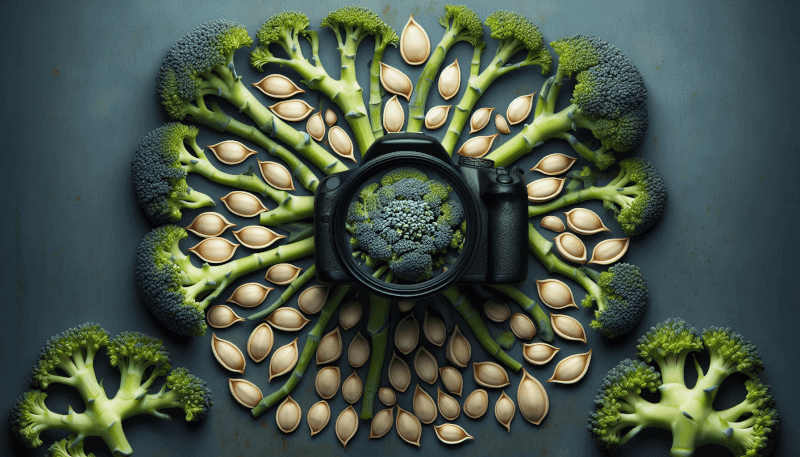Have you ever wondered what the seeds of broccoli look like? In this article, we will explore the captivating world of broccoli seeds and unveil their unique appearance. Get ready to be amazed as we take a closer look at these tiny seeds that hold the potential for growing one of the most beloved vegetables on our dinner plates. Get ready for a fascinating journey into the world of broccoli seeds!
Broccoli Seeds: Overview
Welcome to the world of broccoli seeds! In this comprehensive article, we will explore everything you need to know about broccoli seeds – from their appearance and texture to the germination process and factors affecting their growth. Whether you’re a seasoned gardener or just starting out, understanding broccoli seeds is essential for a successful broccoli harvest. So let’s dive in and learn more about these tiny powerhouses!
What Are Broccoli Seeds?
Broccoli seeds are the small, compact units that contain all the genetic material for a new broccoli plant. They are produced by the broccoli plant as part of its reproductive cycle. Just like seeds of other plants, broccoli seeds have the potential to grow into new plants when provided with the right conditions. Each seed is packed with all the nutrients and energy needed to support the early stages of growth for the plant.
Where Are Broccoli Seeds Found?
Broccoli seeds are found inside the broccoli plant after it has gone through the flowering process. The flowers eventually develop into seed pods, which contain the mature broccoli seeds. These seed pods are usually located towards the top of the plant, near the broccoli florets. It’s important to note that the broccoli florets themselves are not the seeds but rather the edible portion of the plant that we typically consume.
Size and Shape of Broccoli Seeds
Broccoli seeds are relatively small in size, measuring around 2 to 4 millimeters in length. They have an oblong shape with a slightly rounded tip, resembling tiny grains of rice. These seeds may look unassuming, but their potential for growth is immense. Despite their small size, each seed holds the key to producing a whole new broccoli plant.
Color of Broccoli Seeds
Initial Color of Broccoli Seeds
When fresh, broccoli seeds have a distinct dark brown or black color. This initial color is a natural characteristic of the seeds and is primarily influenced by the pigments present in the seed coat. It’s important to note that the color of the seeds may vary slightly depending on the broccoli variety, but the dark hue is typically consistent across different types of broccoli seeds.
Color Changes During Germination
As the germination process begins, the color of broccoli seeds can undergo subtle changes. One notable color change is the emergence of a pale, almost white, sprout from the seed coat. This sprout will eventually develop into the first set of leaves for the growing broccoli plant. Watching the transformation from dark seeds to vibrant green sprouts can be an exciting part of growing broccoli from seeds.
Texture of Broccoli Seeds
Smoothness of Broccoli Seeds
Broccoli seeds have a smooth outer surface, characteristic of their mature seed coat. This smoothness makes it easier for the seeds to slide through the soil and establish themselves during germination. When handling broccoli seeds, you may notice a slight oiliness on the surface, which is a natural protective coating that helps keep the seed moist and viable.
Seed Coat Texture
The seed coat of broccoli seeds has a thin yet sturdy texture. This protective layer plays a vital role in shielding the inner seed and providing it with the necessary protection against external factors such as temperature changes, moisture loss, and pests. The seed coat gradually breaks down as the seed germinates, allowing the emerging sprout to grow and establish itself.

Broccoli Seed Packaging
Commercial Packaging of Broccoli Seeds
Broccoli seeds are readily available for purchase in various commercial packaging options. These include seed packets, seed tapes, and seedling trays. Seed packets are the most common form of commercial packaging, typically containing a specific quantity of seeds suitable for a given area. Seed tapes, on the other hand, are pre-spaced seeds attached to a biodegradable tape, making sowing more convenient and precise. Seedling trays come with individual compartments for each seed, allowing for easy germination and transplanting.
Storage and Shelf Life
Proper storage is crucial for maintaining the viability of broccoli seeds. It’s best to store them in a cool, dry place away from direct sunlight and humidity. Airtight containers or resealable bags can help protect the seeds from moisture and pests. When stored under optimal conditions, broccoli seeds can retain their viability for up to five years. However, it’s always recommended to use fresher seeds for better germination rates.
Germination Process of Broccoli Seeds
Initial Process
The germination of broccoli seeds begins when they are provided with the right conditions for growth. These conditions typically include moisture, warmth, and oxygen. When exposed to favorable environmental conditions, the seed coat softens, allowing water to penetrate and initiate the germination process. The absorbed water triggers biochemical changes within the seed, activating enzymes responsible for breaking down stored nutrients and initiating cell division.
Timeframe for Germination
Broccoli seeds are relatively quick to germinate compared to other plant seeds. Under optimal conditions, you can expect to see the first signs of germination within 5 to 7 days. However, germination rates can vary depending on factors such as temperature and seed quality. It’s important to be patient during this process and provide consistent care to ensure successful germination.
Factors Affecting Germination of Broccoli Seeds
Several factors can influence the germination of broccoli seeds. Understanding and managing these factors is crucial for ensuring high germination rates and healthy plant development.
Temperature
Temperature plays a crucial role in broccoli seed germination. The ideal temperature range for germinating broccoli seeds is between 70°F and 85°F (21°C and 29°C). Cooler temperatures can delay germination, while excessively high temperatures can inhibit germination and affect overall seedling health.
Moisture
Adequate moisture is essential for triggering seed germination. Broccoli seeds require consistent moisture levels to absorb water and activate the biochemical processes necessary for growth. However, excessive moisture can lead to rot and fungal diseases, so it’s important to maintain a balance by providing enough water without overwatering.
Light
Broccoli seeds do not require light to germinate, as they primarily rely on internal stored nutrients to initiate growth. In fact, darkness can sometimes promote better germination rates by allowing the seeds to focus their energy on root development. Once the seedlings emerge, providing them with sufficient light is crucial for healthy growth.
Quality of Seeds
The quality of broccoli seeds is a significant factor in determining germination success. High-quality seeds are more likely to germinate and produce healthy seedlings compared to older or poorly stored seeds. When purchasing broccoli seeds, it’s advisable to choose reputable seed suppliers and opt for fresh, properly stored seeds.
Identifying Good Broccoli Seeds
Seed Health and Vitality
Inspecting the health and vitality of broccoli seeds is essential when selecting seeds for planting. Good broccoli seeds should appear plump, firm, and without signs of damage or disease. Avoid seeds that are discolored, shriveled, or have visible mold. By choosing healthy seeds, you increase the chances of successful germination and robust plant growth.
Uniformity of Size and Shape
Broccoli seeds should have relatively uniform size and shape within a given batch. While slight variations are normal, a noticeable difference in size or shape may indicate poor seed quality or improper seed production. Uniform seeds ensure consistent germination and help with sowing and spacing during planting.
Broccoli Seeds vs. Broccoli Florets
Differences in Appearance
It’s important to differentiate between broccoli seeds and broccoli florets. While broccoli seeds are small and dark, resembling grains of rice, broccoli florets are the large, edible, flower-like structures that we typically consume. Broccoli florets are harvested before the plant enters the seed stage and are often green or purple, depending on the variety. Understanding these differences can help you navigate the various stages of broccoli growth.
Nutritional Composition
While both broccoli seeds and florets are nutrient-rich, there are some variations in their nutritional composition. Broccoli seeds, being the embryonic stage of the plant, are packed with essential nutrients, including proteins, carbohydrates, and healthy fats. On the other hand, broccoli florets are known for their high vitamin and mineral content, particularly vitamin C, vitamin K, and folate. Incorporating both seeds and florets into your diet can provide a wide range of health benefits.
Collecting Broccoli Seeds at Home
Harvesting Broccoli Seeds
If you’re interested in saving and replanting broccoli seeds, it’s possible to harvest them at home. To do so, allow some broccoli plants to fully mature, allowing the flowers to turn into seed pods. Once the seed pods turn brown and dry, it’s time to harvest the seeds. Cut the seed pods and place them in a dry, well-ventilated area to continue drying. Gently rubbing the pods can release the seeds, which can then be separated from the remaining plant material.
Drying and Cleaning the Seeds
After harvesting, it’s important to dry and clean the broccoli seeds properly. Spread the seeds in a single layer on a clean, dry surface and allow them to air dry for several weeks. Once the seeds are fully dry, remove any remaining plant debris or chaff. This can be done by gently rubbing the seeds between your hands or using a sieve or strainer to separate them from unwanted material.
Storing Broccoli Seeds
To ensure the longevity of saved broccoli seeds, proper storage is essential. Place the dried and cleaned seeds in airtight containers or sealed bags to protect them from moisture and pests. Store the containers in a cool, dark, and dry location, such as a pantry or refrigerator. With proper storage, broccoli seeds can remain viable for several years, allowing you to enjoy the benefits of home seed saving.
Buying Broccoli Seeds
Online Seed Retailers
If you prefer to purchase broccoli seeds, there are numerous online seed retailers available. These retailers offer a wide variety of broccoli seeds, including organic, heirloom, and hybrid options. When buying seeds online, it’s important to read customer reviews, check the reputation of the seller, and ensure that the seeds are fresh and properly stored.
Seed Catalogs
Seed catalogs are a great resource for finding a diverse range of broccoli seeds. Many seed companies produce catalogs that showcase their seed offerings, providing detailed descriptions and information on each variety. These catalogs often include valuable tips and recommendations for successful seed starting and growing. Exploring seed catalogs can be a delightful way to discover new and exciting broccoli varieties.
Local Nurseries
Local nurseries and garden centers are excellent places to find broccoli seeds. They usually carry a selection of seeds specifically suited for local growing conditions. Additionally, the staff at nurseries can provide expert advice on seed selection, planting techniques, and caring for your broccoli plants. Supporting your local nurseries not only benefits your garden but also helps the community thrive.
As you can see, broccoli seeds are fascinating little powerhouses with the potential to grow into nutritious and delicious broccoli plants. By understanding their appearance, texture, germination process, and factors affecting their growth, you can confidently sow and cultivate your own broccoli crop. Whether you’re collecting and saving seeds at home or purchasing them from reputable sources, the journey of growing broccoli from seeds is a rewarding and enjoyable experience. So, grab your gardening gloves and get ready to embark on a broccoli-filled adventure!
